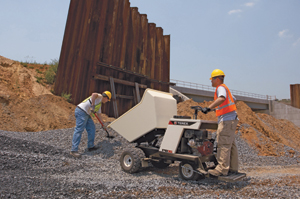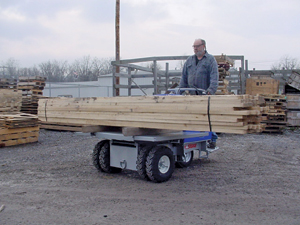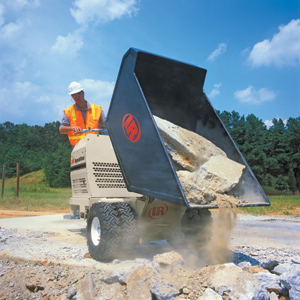A Buggy’s Life
 Glancing around a jobsite, it’s easy to take notice of the large equipment — gargantuan excavators and wheel loaders — that are great in size and even more impressive in operation. But it’s also important not to discredit the small machines of the construction microcosm, like the skid steers, the compact utility loaders and the power buggies. While mini in stature, they are big on performance. Like the ants of the construction equipment ecosystem, power buggies crawl onto the jobsite and muscle hefty loads — in one compact package.
Glancing around a jobsite, it’s easy to take notice of the large equipment — gargantuan excavators and wheel loaders — that are great in size and even more impressive in operation. But it’s also important not to discredit the small machines of the construction microcosm, like the skid steers, the compact utility loaders and the power buggies. While mini in stature, they are big on performance. Like the ants of the construction equipment ecosystem, power buggies crawl onto the jobsite and muscle hefty loads — in one compact package.
“Power buggies have traditionally been used in the transporting and spreading of concrete,” says David Spears, product manager for Terex Power Products. “In recent years, they have been utilized to transport a multitude of materials around jobsites and are especially helpful in work sites where large equipment won’t fit.”
While power buggies are commonly found in concrete and general construction environments, they are also used regularly in the removal of construction debris, landscaping, agricultural operations, cemetery work and grounds maintenance.
Although these buggies are relatively simple machines — comprised of a bucket, wheels and a lot of power — a contractor and his or her crew should understand how the machine works and what considerations to make before rolling onto the jobsite.
The Pieces and Parts of a Buggy
Power buggies are generally categorized by their bucket sizes, typically ranging from 11 to 21 cu ft. Major manufacturers of these mini movers include Miller Spreader Co., Terex, Multiquip, Stone Construction Equipment and Ingersoll Rand. The price of a power buggy can range from $6,000 to $15,000 per unit, depending on options.
A 16-cu ft bucket is the most popular size machine as it has a high carrying capacity, but is still small enough to get through a standard 36-in. doorway, says Ed Varel, engineering project manager for Stone Construction Equipment.

“If you’re working with extremely hot asphalt, which could melt a poly bucket, or in debris removal, which could puncture a poly bucket, you will want to opt for steel,” explains Varel. “However, most power buggies have the ability to swap buckets to offer the best of both worlds.”
If a bucket isn’t ideal for an application, power buggies can also be equipped with a 10-cu ft stake bed or flat bed, making these machines perfect for maneuvering pallets along a crowded site — especially in landscape applications. Stone Construction Equipment offers a stake bed option in its product line.
“Stake bed buggies are perfect for hauling bricks, lumber or any material that is too cumbersome to fit within a buggy bucket,” says Varel. “They are also available with a dump-truck-like bucket that has steel sidewalls at 90 degrees and a rear hatch for dumping mulch or gravel. The stake bed option has become increasingly popular with landscape contractors.”
To ensure that a power buggy can confidently roll onto a jobsite and muscle massive loads, it needs to be outfitted with the right tires for the specific applications. Power buggies typically come standard with pneumatic tires, however, foam filled and non-marking tires are also available for particular tasks.
Foam filled tires rule supreme in areas such as demolition work as they help eliminate downtime with flats. “Foam filled tires are puncture resistant and virtually maintenance free,” says Spears. “Foam filled tires are ideal on worksites with sharp debris that could easily puncture tires.” These types of tires also increase the stability of the machine, adding weight in the proper places for a lower center of gravity — decreasing chance of a rollover, explains Fred Russell, assistant sales manager for Miller Spreader Co. Non-marking tires are also a popular choice among concrete jobsites where tire marks are undesirable or prohibited.
If tires are not suitable for a certain application, tracks are also available through Miller Spreader Co. as an option on some buggy models. Tracks are smoother to operate and easier on delicate surfaces (they don’t tear up the jobsite like tires), which can make track models great for landscaping and other sensitive project sites. However, tracks are not an option that is widely offered, but something that might become more prevalent in the future, says Varel.
With the many ways a power buggy can be configured for specific applications, contractors need to understand how each option helps customize his or her machine for certain tasks — before they buy or rent the equipment and take it to work.
Jobsite Infestation
With jobsite dimensions shrinking and massive loads needing to be moved, the demand for compact power buggies continues to grow. Despite an economic downturn, the power buggy market typically produces between 2,000 and 5,000 units per year and is growing one to three percent a year, says Spears.

“Look for a power buggy with the ability to dump with a low overhang and the ability to feather the load in both forward and reverse,” adds Spears. “Foot pedals are also helpful when dumping and braking, allowing the operator to keep both hands on the handlebars at all times.”
Since not every project calls for the same specifications, a buggy must be outfitted with the right options to ensure efficient work. With a much larger hauling capacity than a wheelbarrow, power buggies are ideal workhorses in landscape applications. To prepare the machine for such work, a poly or steel bucket can be used, as well as a stake bed. Both tires and tracks may be suitable for landscape duties depending on the surface condition the buggy will be performing on.
“Provided the grade is relatively level and compacted, a wheeled power buggy will do less damage to the lawn,” explains Russell. “Softer grades or uneven grade may warrant the use of a track machine.”
As for concrete-specific tasks — the most common use for power buggies — the machine should be equipped with a poly bucket as it is easy to clean after use. Foam filled tires are recommended for concrete jobsites as they are less resistant to flats. According to Varel, a 16-cu ft, poly bucket machine with foam filled tires and quick-disconnect wheels to get through doorways easily is the most popular configuration for this type of work.
After using a power buggy, whether in landscape, concrete or good ol’ construction work, proper cleanup and maintenance should be performed. Although a power buggy is a relatively low maintenance machine, there are a few easy upkeep guidelines to follow. A daily check of the machine’s basic components is important to keep the buggy running efficiently.
“Oil and fuel should be checked on a daily basis,” says Spears. “Hydraulic systems and tires should be checked regularly for normal wear and tear, as well as any items identified in the operator’s manual.”
To keep the buggy’s bucket in top notch shape, special attention should be paid to it before and after each use. Form release agents may be applied to the bucket (especially when working with concrete) before use so materials come off of its surface easier. Russell suggests washing the bucket with a brush and water immediately after each use, and shielding poly buckets from UV rays when not in operation.
When loads get too heavy to move with a standard wheelbarrow, crews can look to power buggies for the muscle to get the job done. Whether it’s hauling a pile of mulch for a landscape project or maneuvering fresh concrete to cover a surface, these small but powerful pieces of equipment carry their own weight and then some.
Pam Stask is assistant editor of Compact Equipment, based in Peninsula, Ohio.

Comments are closed here.